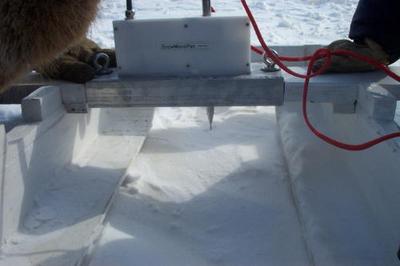26 April, 2002
Despite the fact that we have arrived at our
destination point some work still needs to be
finished in Barrow. I will be here until Monday,
the 29th of April. The team is tired and the warm
showers and bed provided by NARL is much
appreciated. Members of the team will scatter
back to the safety of their families depending on
their flight plans. Today Jon and Glen returned
home. I would like to acknowledge all of the work
Glen has put into the TEA journals. Many of the
photos in the journals have been due to Glen's
patience and persistence. He also has
accompanied me on late nights proofreading the
journals to ensure an accurate education of the
science. He also provided the daily
latitude/longitude coordinates and the
temperature readings. The journals would not
have been posted without his assistance! Once
again, teamwork by SnowSTAR 2002!
Spring is beginning to arrive in the Arctic. The
snow will eventually melt and the tundra will be
exposed. Today the temperatures were above
freezing. The snow became a slushy, melty mess.
The wind blew at sustained 40 miles per hour
winds causing sublimation to occur. Sublimation
is when the snow in the solid state of water
transforms to the gaseous state of water. Despite
the wind, the last Class 2 chemical samples were
taken. They were shipped to Fairbanks with the
other samples for later testing.
There is one measurement in which there has been
no lesson and that is the penetrometer. The last
two lessons will be on the penetrometer.
PENETROMETER
A dull, computerized, buzzing sound fills the
quite, Arctic landscape. It hums as it
penetrates the snow with its rocket point.
"Stop", "Stop", - Ready for Data. "OK"- Taking
Data. The metal rocket point begins to move down
and penetrates the snow pack. Two people hold the
devicethat appears as a white sled, down so it
will not be knocked loose from hitting the dense
snow pack. One person sits in the heated sled
running the computer that collects the data.
These are the sights and sounds of the
Penetrometer. The penetrometer measures the
hardness of the snow pack. It is a computerized
controlled device. The hardness of the snow
correlates with the density of the snow within
the layers. The harder the snow, the more dense
the snow. Hardness has many applications. It can
give us many clues and answers to the mysteries
of the snow and how it affects our entire global
climate. It is a key component of understanding
how snow interacts and plays a role with our
environment. The hardness of the snow can play a
factor in how the snow is transported across the
landscape and air. One application of hardness
is that it can give clues to the mysteries of
caribou migrations and populations. Caribou can
stand on hard snow without breaking through the
layer. However, on less dense snow they have
trouble walking and break through the snow pack.

Matthew and Glen running the Penetrometer.

The point on the penetrometer that impacts the snow.
Contact the TEA in the field at
.
If you cannot connect through your browser, copy the
TEA's e-mail address in the "To:" line of
your favorite e-mail package.
|
